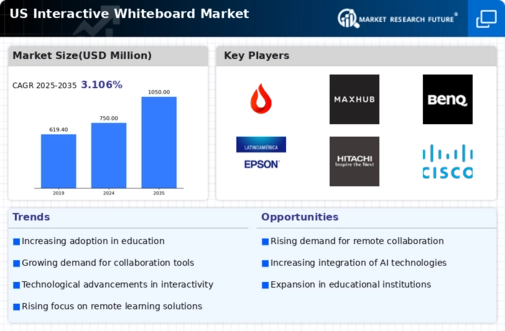The US Interactive Whiteboard Market is characterized by technological sophistication and rapid innovation, reflecting advancements in education and corporate presentations. This sector has become increasingly competitive, while various entities strive to enhance their offerings through integration with learning management systems and collaborative tools. The market dynamics are influenced by numerous factors, including an increasing demand for interactive learning experiences in educational institutions and the need for efficient communication tools in corporate environments. As educational methods evolve towards more engaging and collaborative approaches, companies that provide interactive whiteboards must continually adapt their technologies and marketing strategies to stay relevant.
The competitive landscape comprises established players along with emerging startups, all vying for market share through superior technology and customer engagement.
Promethean stands out in the US Interactive Whiteboard Market by leveraging its longstanding heritage in educational technology. The company is recognized for its commitment to providing high-quality interactive whiteboards that facilitate immersive learning experiences and collaborative teaching methods. Promethean's products are designed to enhance interactivity in classrooms, featuring intuitive software tools that allow teachers and students to engage actively with the material. The company has established a profound market presence, not only due to its cutting-edge technology but also because of its extensive professional development programs that help educators maximize the potential of their interactive boards.
The strength of Promethean lies in its ability to generate educational content that is aligned with curriculum standards, making it a preferred choice among institutions looking to integrate interactive technology into their learning environments.
d2l has made significant inroads in the US Interactive Whiteboard Market through its innovative approach to learning solutions, particularly with its Brightspace platform, which integrates seamlessly with interactive whiteboards for enhanced educational outcomes. This company focuses on delivering a comprehensive suite of educational tools designed to foster student engagement and improve learning analytics. d2l's strength lies in its adaptability, allowing educational institutions to customize their interactive learning environments according to specific curricular needs. The company is recognized for its strategic partnerships and collaborations that enhance its market presence and expand its service offerings.
Additionally, d2l has pursued targeted mergers and acquisitions to bolster its portfolio, further strengthening its capabilities in providing interactive solutions tailored to the demands of the US educational landscape. By maintaining a student-centered approach, d2l is effectively positioning itself as a key player in enhancing interactive learning experiences in the region.























